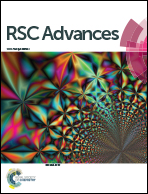Light-responsive fluids based on reversible wormlike micelle to rodlike micelle transitions†
Abstract
A new class of light-responsive fluids based on reversible transitions between wormlike micelles and rodlike micelles is developed. The system is composed of a synthesized light-responsive surfactant, 4-decylazobenzene-4-(oxyethyl)-dihydroxyethylmethylammonium bromide (C10AZODEMAB), and a salicylic acid derivative, 5-methyl salicylic acid (5 mS). 5 mS is highly efficient in inducing the micellar growth of C10AZODEMAB at a constant concentration, i.e., [C10AZODEMAB] = 30 mmol L−1. Viscoelastic fluids are formed in a wide concentration region of 5 mS, and show UV light-induced shining behaviors. More importantly, they can return to their original states after visible light irradiation. Cryogen transmission electronic microscopy (cryo-TEM) and rheology measurements confirm that the light-induced rheological responses are attributed to the reversible transitions between wormlike micelles and rodlike micelles. UV-Vis and 1H NMR spectra are employed to study the molecular interactions between C10AZODEMAB and 5 mS before and after light irradiation systematically, which evidence the critical role of light-induced isomerization between trans-C10AZODEMAB and cis-C10AZODEMAB during the transition process well.


 Please wait while we load your content...
Please wait while we load your content...